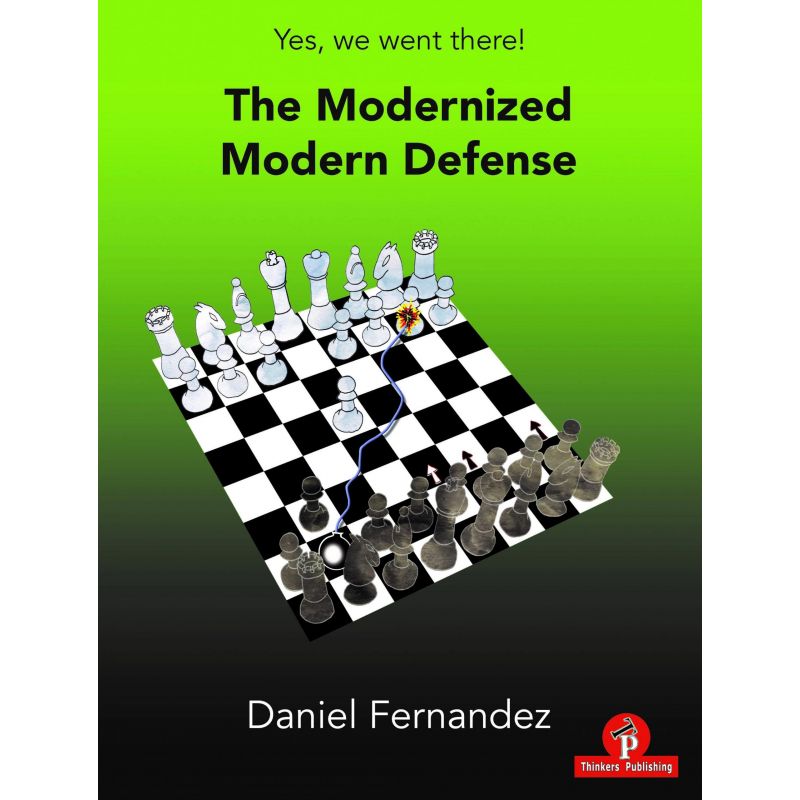10 x ZESTAW SZKOLNY III: figury plastikowe Staunton nr 6 + szachownica tekturowa składana na pół (Z-16)
PAKIET 10 ZESTAWÓW SZKOLNYCH - IDENTYCZNY ZESTAW DO TYCH UŻYWANYCH W PROJEKCIE "EDUKACJA PRZEZ SZACHY W SZKOLE"
PAKIET 10 ZESTAWÓW SZKOLNYCH - IDENTYCZNY ZESTAW DO TYCH UŻYWANYCH W PROJEKCIE "EDUKACJA PRZEZ SZACHY W SZKOLE"
Nowe rozszerzone wydane - 2020 r. II wydanie., 280 str., miękka oprawa, dobra poligrafia , język polski.
Cytat I ze Wstępu: „Szybki Kurs Debiutów omawia przede wszystkim otwarcia w jednym tomie i jest przeznaczony przede wszystkim dla szerokiej rzeszy sympatyków królewskiej gry. Dzięki niej każdy może szybko zapoznać się z ogólnymi tajemnicami teorii otwarć, głównymi ideami i planami, co wydatnie pomoże w rozgrywaniu partii”.
Cytat II: „Każda faza partii, otwarcie, gra środkowa i końcowa ma duże znaczenie. Jeżeli na początku gry, któraś ze stron uzyska przewagę materialną lub pozycyjną, to zniwelować ją w grze środkowej będzie bardzo trudno. W tej sytuacji do końcówki może w ogóle nie dojść. Bez poprawnej gry w debiucie, nie można więc myśleć o sukcesach w szachach.
PROFESJONALNE SZACHY TURNIEJOWE ( rozmiar szachownicy oraz figur zgodny w wytycznymi Polskiego Związku Szachowego oraz FIDE)
Szachy drewniane, składane ze specjalna kasetką na figury.
Figury turniejowe Staunton nr 5, obciążone, podklejane filcem.
Szachownica intarsjowana naturalny mahoń
Wymiar szachownicy: 47 x 47 x 2,5 cm;
Wymiar pola szachowego: 48 x 48 mm;
Wysokość króla: 93 mm; pionek: 4,5 cm;
Waga łączna: 2,00 kg;
Zestaw zawiera dwa dodatkowe hetmany.
Najnowszy zegar renomowanej holenderskiej firmy DGT!
Zegar idealny dla szkół i klubów szachowych!
Zegar DGT 1001 ma duży, przejrzysty wyświetlacz ( 11,5 x 2 cm), jest prosty w obsłudze i klasyczny w swoim wyglądzie.
Największą jego zaletą jest jednak cena - dużo niższa niż cena większości dostępnych na rynku zegarów.
Możliwość różnych ustawień oprócz tempa gry z dodawaniem czasu.
Wymiary: 15,5 x 6 x 4 cm
Zegar zasilany jedną bateria ( paluszek AA). Bateria w komplecie.
Breloki szachowe figury drewniane mix.
Atrakcyjnie wyglądająca pamięć USB w kształcie króla
Wykonanie: drewno egzotyczne
Pojemność: 64 GB
Wymiary:
- wysokość: 90 mm
- średnica: 30 mm
Produkt dostępny wyłącznie w formie pobrania
Nowe książeczki ChessBase zawierają kod aktywacyjny, który umożliwia pobranie produktu. ChessBase 18 oraz nowe bazy danych nie będą już wydawane na DVD-ROM. Szczegóły na końcu opisu.
ChessBase to samodzielna baza danych szachowych, która stała się światowym standardem. Korzystają z niej wszyscy – od mistrzów świata po amatorów. Jest to ulubiony program każdego miłośnika szachów, który chce poszerzyć swoją wiedzę i umiejętności. Rozpocznij swoją osobistą przygodę z sukcesami dzięki ChessBase i ciesz się grą jeszcze bardziej.
Kompletna edycja książek z serii WESOŁE SZACHY wydana w jednym podręczniku.
Ten kompleksowy podręcznik dla najmłodszych szachistów zawiera nie tylko wszystkie 3 części "Wesołych Szachów, ale także część 4 - czyli całkowitą nowość, dotychczas nigdy nie wydaną!
Niezwykle istotne jest zapoznanie się z dorobkiem twórczym mistrzów świata. Czego można się nauczyć od nich? Z całą pewnością bardzo wiele. Każdy z nich był bowiem najwybitniejszym graczem swoich czasów i na drodze do tytułu najsilniejszego zawodnika globu musiał pokonać elitę najlepszych z najlepszych oponentów w rozgrywkach eliminacyjnych i w końcu zwyciężyć w meczu finałowym! W tych trudnych i emocjonujących spotkaniach musiał wykorzystać wszystkie swoje umiejętności oraz wiedzę, aby rozłożyć na łopatki wielu znakomitych przeciwników!
Szachy drewniane turniejowe w rozmiarze idealnie dopasowanym do dzieci w wieku 6-10 lat !!
Figury szachowe - drewniane, wykonane w klasycznym kształcie.
Zastosowany rozmiar figur to idealne rozwiązanie dla dzieci, które zaczynają swoją przygodę z królewską grą.
Szachownica - klasyczna składana na pół szachownica w formie zamykanej kasetki, wewnątrz której znajdziemy miejsce na figury.
Dzięki temu, że szachownica jest składana i można w niej przechowywać figury, zestaw jest prosty w użyciu i transporcie.
Szachy idealnie sprawdzą się jako narzędzie treningowe, które można mieć właściwie zawsze przy sobie.
Drewno: Grab, Buk, Akacja
Waga zestawu: ok.1 kg
WYPRODUKOWANE W POLSCE!
Szachy drewniane
Wymiary: 270 x 470 x 50 mm
Król: 85 mm
Waga: 1,1 kg
Kieszonkowe Szachy Magnetyczne w NOWEJ ODSŁONIE 2.0
Tym razem – składane na 3, dzięki czemu zyskały miejsce na "zbite" figury.
Dodatkowo wprowadzono notację, której brak czasem krytykowano w poprzedniej edycji.
Poręczny towarzysz w podróży w Twojej kieszeni!
Od dziś możesz grać w szachy gdziekolwiek i kiedykolwiek zechcesz!
- Idealne do analizy partii!
- Szachy wykonane są z tworzywa sztucznego.
- Zewnętrzna strona zrobiona została z ekoskóry.
- Materiał: Vinyl, ekoskóra, plastik
Szachownica i figury wykonane są z drewna.
Wymiary: 420 x 210 x 50 mm
Król: 78 mm
Waga 1.60 kg
Szachownica i figury wykonane są z drewna.
Wymiary: 420 x 210 x 50 mm
Król: 78 mm
Waga 1.60 kg
 Nowy elektroniczny zegar szachowy LEAP KK9908
Nowy elektroniczny zegar szachowy LEAP KK9908
Charakterystyka zegara:
• zegar z atestem FIDE!
• opcja dodawania czasu
• 37 ustawień zegara dla szachów oraz różnych gier
• maksymalna prostota obsługi
• duży, czytelny wyświetlacz pozwala na odczytanie czasu nawet z odległości 10m!
waga: 0,2 kg
Najlepiej sprzedające się szachy od lat.
Najlepszy stosunek jakości do ceny.
Szachownica i figury wykonane z drewna.
SZACHOWNICA wypalana, składana na pół,
w środku znajduje się wkładka na figury szachowe
FIGURY drewniane, wypalane, podklejane zielonym filcem
Wymiary szachownicy: 54 x 54 x 3 cm
Wymiar pola: 55 x 55 mm
Król: 110 mm
Waga 2.50 kg
Autor przygotował materiał, który zawiera propozycje gry wariantów przeciwko debiutom zamkniętym i pół zamkniętym Każdemu debiutowi autor poświęcił tyle miejsca, na ile zasługuje ze względu na bogactwo wariantów i częstość jego występowania w praktyce turniejowej. Autor celowo ominął większość systemów z nieprzyjętego gambitu hetmańskiego, które w zasadzie powinny być obowiązkowe w repertuarze debiutowym zawodnika rozpoczynającego partię posunięciem 1.d2-d4.
Autor przygotował materiał, który zawiera propozycje gry wariantów przeciwko debiutom otwartym i półotwartym. Każdemu debiutowi autor poświęcił tyle miejsca, na ile zasługuje ze względu na bogactwo wariantów i częstość jego występowania w praktyce turniejowej.
Playing the Modern Defense with any regularity is a sign that you truly love chess. From the very first move, you are indicating to your opponent (and to the jury deciding on the brilliancy prizes!) that you would like to play an unbalanced position. Then the thrill of the fight courses through your veins and you simply must trust yourself to handle developments better than the other player. For a very long time this truly was the absolute frontier, the Wild West of opening theory: if it went well you looked like a genius, if it goes badly you got mated in 20 moves, and most likely neither of you ever really made the analysis which you so badly needed to remember at the board.
A certain air of reckless abandon, of pure devil-may-care mischief, was needed to play it successfully, and to some extent still is. Something of this passion was conveyed into printed form by Swedish GM Tiger Hillarp Persson when he wrote his Tiger’s Modern. Even within the Modern, the crème de-la-crème of the opening, when I learned it from his book almost a decade ago was the famous Hippo setup, the epitome of the adventurer’s spirit.
While White goes about stationing his pieces aggressively, controls the centre, etc., Black nonchalantly places nearly all his pawns on the third rank and shuffles his pieces behind them! For some reason this appealed to the 15-year-old me: the idea that I could take the game to my opponent in a way that I chose, rather than by preparing endlessly for some subtlety on move 27 of the Poisoned Pawn Najdorf.
Throughout the year 2010 I played the Modern almost exclusively; it filled the gap between my 1 ... e5 phase and my 1 ... c6 phase. (The latter remained my main reply to 1.e4 until I began learning the Najdorf in 2018, but I do still enjoy regularly mixing it up with the Modern; there are more than 20 references to my own games in the text.) What might surprise you is that 2010 was the year in which my chess career started progressing by leaps and bounds! I became an IM relying very heavily on it; an example from one of my norm tournaments can be seen in Part I (Lahiri-Fernandez.) I embraced the complexity, the audacity and the novelty whole-heartedly, and it embraced me back.

Gwarancja zwrotu pieniędzy

Bezpieczne i szybkie dostawy

Bezpieczeństwo transakcji dzięki certyfikatowi SSL
Times are changing (as even the Wild West at some point became industrialized) and theory has developed on everything. It has therefore become possible, inter alia, to try and write a rigorous opening manual on the Modern. What I mean is not that equality has been found and this should be your exclusive opening choice for all time to come (I would be lying to you if I said that) but rather that there is now a roadmap as to how you should study this opening. About time, given the number of 1.e4 repertoires that have been written and which contain anti-Modern recommendations (usually in the ‘Other’ or ‘Miscellaneous’ section towards the back!) that nobody has taken the time to combat rigorously.
Furthermore, there has been a sea change in the ethos of Modern players (and also Pirc players): we no longer wish to get something totally new, or redefine the concept of development in Hippo style, but usually these days we want to get a Sicilian structure! That is to say, a position where Black gets to play ... cxd4 (or have White play dxc5) and thereby obtains a central majority that will stand him in good stead for the long term. That has now become the intellectual gold standard, a trend that has progressed in tandem with the inclusion of this opening in more players’ repertoires and its slow shift in towards the mainstream from the fringes of what is acceptable.
As artisans (for we must never forget our roots) on this moving fringe, it is important to have your bearings. Nowadays (and however much you feel like playing it freehand) if you want to include the Modern in your repertoire you should do some study. You should know, for instance, where White can get a safe plus (in my opinion, just chapter III.2), where White can get a less-safe plus (chapter IV.4), and where there are routes to equality, dynamic or otherwise (essentially the rest of the book!)
SPIS TREŚCI:
004 Key to Symbols & Bibliography
007 Introduction to the Modernized Modern
013 PART I - Illustrative games
PART II - Pirc Transpositions
043 Chapter 1 - System with 4.Be3
071 Chapter 2 - Austrian Pirc without 6.Bb5+
095 Chapter 3 - Austrian Pirc with Bxd7
117 Chapter 4 - Austrian Pirc with 8.e6
135 Chapter 5 - Classical Pirc with 7.Bf4 and 7.Bg5
159 Chapter 6 - Classical Pirc Other 7th moves
PART III - Systems Chess
179 Chapter 1 - The 4.Bc4 Variation
199 Chapter 2 - Other bishop-move systems
219 Chapter 3 - Systems with a preventative 5.a4
237 Chapter 4 - Systems with 3.c4 or 4.c4
257 Chapter 5 - Systems Chess links for Black
PART IV - Theoretical Pure Moderns
279 Chapter 1 - Four Piece Systems
301 Chapter 2 - Austrian Modern without the early Be3
325 Chapter 3 - 150 Attack without 6.f3
355 Chapter 4 - 150 Attack with 6.f3
Opis
Szczegóły produktu
"Winning with 1.d4!" offers a complete repertoire for d4 players against all plausible responses. The recommendations were selected with the main goal of enabling the reader to leave out vast amounts of opening theory and to concentrate on a comprehensible number of lines that promise some initiative and active play and often even an opening advantage. Here is what you can expect from "Winning with 1.d4!":
Well chosen promising opening systems from the abundance of theory
- Easily understandable presentation and thorough discussion of ideas and plans
- Novelties and other discoveries from current tournaments, both in classical and in correspondence chess
- Annotated games for your practical training
FM Jerzy Konikowski has published a large number of excellent opening books. Uwe Bekemann is a national master in correspondence chess and has published several books on gambits.
Do you want a simple and practical method to counter Black’s kingside fianchetto defences after 1 d4? A line that takes the initiative from a very early stage and creates difficult practical problems? If so, then The Harry Attack (1 d4 Nf6 2 c4 g6 3 h4!) is for you.
‘To my mind there is quite a straightforward explanation. In order to profit from the initiative granted by the first move, White has to make use of his opportunity to do something before Black has an equal number of opportunities of his own.’ However, to do this he has to make ‘contact’ with the black position. The first point of contact usually comes in the form of a pawn exchange which leads to the opening of the position. The thought behind 1…c5 is this: ‘OK, I’ll let you open the position, and develop your pieces aggressively, but at a price – you have to give me one of your center pawns.’ (Jonathan Rowson, Chess for Zebras: Thinking Differently About Black and White).
BRAK NA MAGAZYNIE - produkt może zostać sprowadzony "NA ZAMÓWIENIE"
What does a chess player need who is familiar with the rules, but often gets into trouble right away in the opening? This question was the starting point for the authors before they began to compile their material.
BRAK NA MAGAZYNIE - produkt może zostać sprowadzony "NA ZAMÓWIENIE"
BRAK NA MAGAZYNIE - produkt może zostać sprowadzony "NA ZAMÓWIENIE"
Chess theory ebbs and flows. Lines that have been discarded for decades suddenly become all the rage and everyone starts playing them. A case in point are queenside openings where White plays Bf4. For years these had been the chess equivalent of flared trousers but in recent times they have been reinvented and even the best players in the world are now sporting them.









